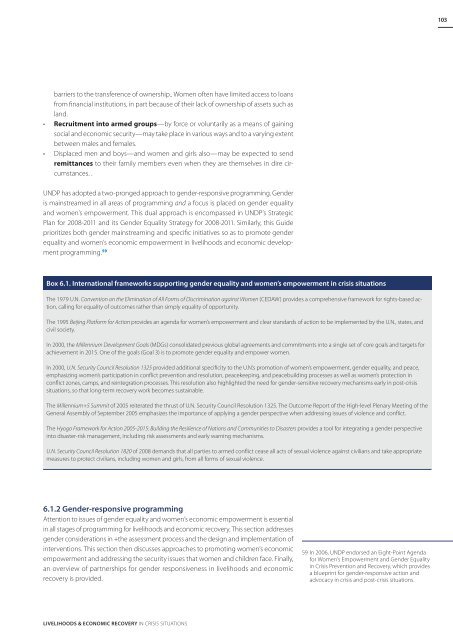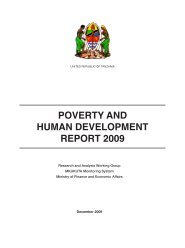Download PDF (4.08 MB) - ReliefWeb
Download PDF (4.08 MB) - ReliefWeb
Download PDF (4.08 MB) - ReliefWeb
You also want an ePaper? Increase the reach of your titles
YUMPU automatically turns print PDFs into web optimized ePapers that Google loves.
103<br />
barriers to the transference of ownership.. Women often have limited access to loans<br />
from financial institutions, in part because of their lack of ownership of assets such as<br />
land.<br />
• Recruitment into armed groups—by force or voluntarily as a means of gaining<br />
social and economic security—may take place in various ways and to a varying extent<br />
between males and females.<br />
• Displaced men and boys—and women and girls also—may be expected to send<br />
remittances to their family members even when they are themselves in dire circumstances.<br />
.<br />
UNDP has adopted a two-pronged approach to gender-responsive programming. Gender<br />
is mainstreamed in all areas of programming and a focus is placed on gender equality<br />
and women’s empowerment. This dual approach is encompassed in UNDP’s Strategic<br />
Plan for 2008-2011 and its Gender Equality Strategy for 2008-2011. Similarly, this Guide<br />
prioritizes both gender mainstreaming and specific initiatives so as to promote gender<br />
equality and women’s economic empowerment in livelihoods and economic development<br />
programming. 59<br />
Box 6.1. International frameworks supporting gender equality and women’s empowerment in crisis situations<br />
The 1979 U.N. Convention on the Elimination of All Forms of Discrimination against Women (CEDAW) provides a comprehensive framework for rights-based action,<br />
calling for equality of outcomes rather than simply equality of opportunity.<br />
The 1995 Beijing Platform for Action provides an agenda for women’s empowerment and clear standards of action to be implemented by the U.N., states, and<br />
civil society.<br />
In 2000, the Millennium Development Goals (MDGs) consolidated previous global agreements and commitments into a single set of core goals and targets for<br />
achievement in 2015. One of the goals (Goal 3) is to promote gender equality and empower women.<br />
In 2000, U.N. Security Council Resolution 1325 provided additional specificity to the U.N.’s promotion of women’s empowerment, gender equality, and peace,<br />
emphasizing women’s participation in conflict prevention and resolution, peacekeeping, and peacebuilding processes as well as women’s protection in<br />
conflict zones, camps, and reintegration processes. This resolution also highlighted the need for gender-sensitive recovery mechanisms early in post-crisis<br />
situations, so that long-term recovery work becomes sustainable.<br />
The Millennium+5 Summit of 2005 reiterated the thrust of U.N. Security Council Resolution 1325. The Outcome Report of the High-level Plenary Meeting of the<br />
General Assembly of September 2005 emphasizes the importance of applying a gender perspective when addressing issues of violence and conflict.<br />
The Hyogo Framework for Action 2005-2015: Building the Resilience of Nations and Communities to Disasters provides a tool for integrating a gender perspective<br />
into disaster-risk management, including risk assessments and early warning mechanisms.<br />
U.N. Security Council Resolution 1820 of 2008 demands that all parties to armed conflict cease all acts of sexual violence against civilians and take appropriate<br />
measures to protect civilians, including women and girls, from all forms of sexual violence.<br />
6.1.2 Gender-responsive programming<br />
Attention to issues of gender equality and women’s economic empowerment is essential<br />
in all stages of programming for livelihoods and economic recovery. This section addresses<br />
gender considerations in +the assessment process and the design and implementation of<br />
interventions. This section then discusses approaches to promoting women’s economic<br />
empowerment and addressing the security issues that women and children face. Finally,<br />
an overview of partnerships for gender responsiveness in livelihoods and economic<br />
recovery is provided.<br />
59 In 2006, UNDP endorsed an Eight-Point Agenda<br />
for Women’s Empowerment and Gender Equality<br />
in Crisis Prevention and Recovery, which provides<br />
a blueprint for gender-responsive action and<br />
advocacy in crisis and post-crisis situations.<br />
Livelihoods & Economic Recovery in Crisis Situations





